-
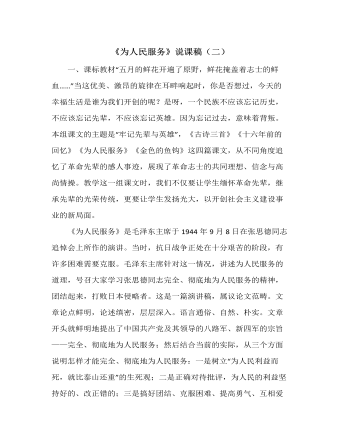
部编人教版六年级下册《为人民服务》说课稿(二)
二、教法学法(一)突出主体,选择教法:课堂是学习的场所,学生是学习的主人。《语文课程标准》明确指出:“积极倡导自主、合作、探究的学习方式”,要充分发挥学生的主体作用,全面提高学生的语文素养。基于以上的认识,我选择教法如下:1.以读为主,读思写结合法;2.引扶放相结合,意在引导学生注意议论文的特点与学习方法,从而培养学生自能读书的能力与习惯。(二)重在实践,指导学法:“语文是实践性很强的课程”,就是要让学生在大量的语文实践中掌握运用语文的规律与方法,也就是既要“授人以鱼”,更要“授人以渔。为此,我指导学生以读为本,体会文章论述方法、抓住重点词句进行理解课文。三、教学过程:(一)回忆旧知,导入新课1.上节课我们通过学习课文,你还记得课文中心论点是什么吗?哪个句子点明了这个观点?(指名答,板书:全心全意为人民服务)2.课文从哪些方面对这个观点展开叙述?(指名答,板书:死的意义、正确对待批评、团结人民)
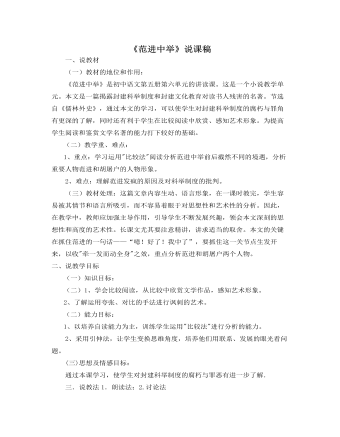
部编版语文九年级上册《范进中举》说课稿
一、说教材(一)教材的地位和作用:《范进中举》是初中语文第五册第六单元的讲读课。这是一个小说教学单元。本文是一篇揭露封建科举制度和封建文化教育对读书人残害的名著。节选自《儒林外史》,通过本文的学习,可以使学生对封建科举制度的腐朽与罪角有更深的了解,同时还有利于学生在比较阅读中欣赏、感知艺术形象。为提高学生阅读和鉴赏文学名著的能力打下较好的基础。(二)教学重、难点:1、重点:学习运用"比较法"阅读分析范进中举前后截然不同的境遇,分析重要人物范进和胡屠户的人物形象。2、难点:理解范进发疯的原因及对科举制度的批判。(三)教材处理:这篇文章内容生动、语言形象,在一课时教完,学生容易被其情节和语言所吸引,而不容易着眼于对思想性和艺术性的分析。因此,在教学中,教师应加强主导作用,引导学生不断发展兴趣,领会本文深刻的思想性和高度的艺术性。长课文尤其要注意精讲,讲求适当的取舍。
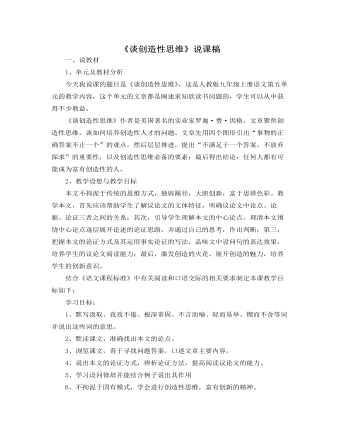
部编版语文九年级上册《谈创造性思维》说课稿
《谈创造性思维》作者是美国著名的实业家罗迦·费·因格。文章聚焦创造性思维,谈如何培养创造性人才的问题。文章先用四个图形引出“事物的正确答案不止一个”的观点,然后层层推进,提出“不满足于一个答案,不放弃探求”的重要性,以及创造性思维必备的要素;最后得出结论:任何人都有可能成为富有创造性的人。2、教学设想与教学目标本文不拘泥于传统的思维方式,独辟蹊径,大胆创新,富于思辨色彩。教学本文,首先应该帮助学生了解议论文的文体特征,明确议论文中论点、论据、论证三者之间的关系;其次,引导学生理解本文的中心论点,理清本文围绕中心论点逐层展开论述的论证思路,并通过自己的思考,作出判断;第三,把握本文的论证方式及其运用事实论证的写法,品味文中设问句的表达效果,培养学生的议论文阅读能力;最后,激发创造的火花,展开创造的魅力,培养学生的创新意识。
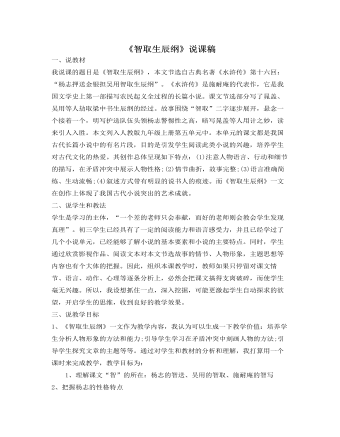
部编版语文九年级上册《智取生辰纲》说课稿
二、说学生和教法学生是学习的主体,“一个差的老师只会奉献,而好的老师则会教会学生发现真理”。初三学生已经具有了一定的阅读能力和语言感受力,并且已经学过了几个小说单元,已经能够了解小说的基本要素和小说的主要特点。同时,学生通过欣赏影视作品、阅读文本对本文节选故事的情节、人物形象,主题思想等内容也有个大体的把握。因此,组织本课教学时,教师如果只停留对课文情节、语言、动作、心理等逐条分析上,必然会把课文搞得支离破碎,而使学生毫无兴趣。所以,我设想抓住一点,深入挖掘,可能更激起学生自动探求的欲望,开启学生的思维,收到良好的教学效果。三、说教学目标1、《智取生辰纲》一文作为教学内容,我认为可以生成一下教学价值:培养学生分析人物形象的方法和能力;引导学生学习在矛盾冲突中刻画人物的方法;引导学生探究文章的主题等等。通过对学生和教材的分析和理解,我打算用一个课时来完成教学,教学目标为
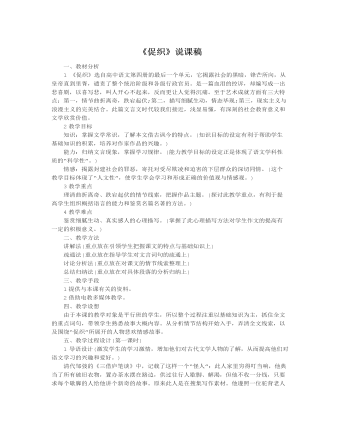
《促织》说课稿2020-2021学年统编版高中语文必修下册
蒲松龄(1640——1715)字留仙,一字剑臣,号柳泉居士。山东淄川(今淄博)人。清代小说家,出身于没落地主家庭。天资聪明,学问深厚,十九岁时连中县、府、道三个第一,但此后屡应省试不第,年七十一,始被补上岁贡生,一生忧郁自伤,穷愁潦倒。从二十岁左右开始写作,历时二十余年,创作了文言短篇小说集《聊斋志异》。另有诗、文集《聊斋诗集》、《聊斋文集》。《聊斋志异》是蒲松龄倾力创作的文言短篇小说集。“聊斋”是作者的书斋名。“志异”就是记述花妖狐鬼及其他一些荒诞不经的奇闻轶事。作者巧妙地通过这些离经虚幻的故事,大胆地揭露社会多方面的黑暗现实,赞美了青年男女敢于冲破封建礼教樊篱的精神,抒发了作者自己满腔的“孤愤”。郭沫若曾题蒲松龄故居联:“写鬼写妖,高人一等;刺贪刺虐,入木三分。”老舍题联:“鬼狐有性格,笑骂成文章。”简明而生动地道出了《聊斋志异》的文学特点。
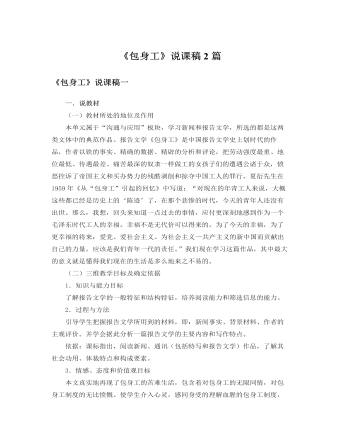
人教版高中语文必修1《包身工》说课稿2篇
(一)解题:包身工──旧社会一种变相的贩卖奴隶的形式。被贩卖的多是女孩子由承办人送到工厂做工,无人身自由,所得工资全部归承办人所有,在这种形式下做工的人也称包身工。包身工是指二三十年代(时间),在上海东洋纱厂里(地点),为外国人工作的女工(工作性质)。因为这些女工在进厂时已经签订了卖身契,失去了人身的自由权,所以被称为“包身工”。标题中的“包身”二字,突出了帝国主义、封建势力对中国女童工的残酷剥削的罪行,控诉了他们的野蛮残暴的统治手段,以激起人们的义愤和同情,这是全文的中心思想。(二)关于报告文学:《包身工》属于报告文学。(同类题材有初中的《地质之光》、《谁是最可爱的人》)报告文学,是文学体裁的一种,散文的一类,是文艺通讯、速写、特写的总称,是文学创作中的“轻骑兵”。
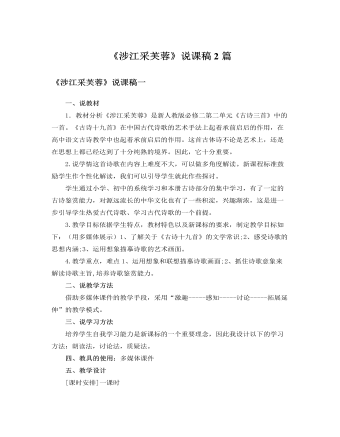
人教版高中语文必修2《涉江采芙蓉》说课稿2篇
一、说教材1.教材分析《涉江采芙蓉》是新人教版必修二第二单元《古诗三首》中的一首。《古诗十九首》在中国古代诗歌的艺术手法上起着承前启后的作用,在高中语文古诗教学中也起着承前启后的作用。这首古体诗不论是艺术上,还是在思想上都已经达到了十分纯熟的境界。因此,它十分重要。2.说学情这首诗歌在内容上难度不大,可以做多角度解读。新课程标准鼓励学生作个性化解读,我们可以引导学生就此作些探讨。学生通过小学、初中的系统学习和本册古诗部分的集中学习,有了一定的古诗鉴赏能力,对源远流长的中华文化也有了一些积淀,兴趣渐浓,这是进一步引导学生热爱古代诗歌、学习古代诗歌的一个前提。3.教学目标依据学生特点,教材特色以及新课标的要求,制定教学目标如下:(用多媒体展示)1、了解关于《古诗十九首》的文学常识;2、感受诗歌的思想内涵;3、运用想象描摹诗歌的艺术画面。

人教版高中语文必修1《鸿门宴》说课稿3篇
3、拓展延伸,启迪心智,创设课堂训练营。三、说学法1、纸上得来终觉浅,圈点、勾画、批注法,学好文言基本功。2、自主合作加探究,眼耳口脑手并用,破疑解难在其中。四、说课时安排《鸿门宴》篇幅较长,文言知识较丰富,文章内涵丰厚,因此我设计用五课时教学本文。第一课时:了解作家作品,积累文言知识,感受作者隐忍发愤的著书精神(初读)第二课时:理清故事情节,概括人物形象,学习客观地评论历史人物,(熟读)第三课时:进一步梳理文言知识,精读课文,要求读透。(精读)第四课时:通过对人物、事件的赏析,加深学生对人物的理解,锻炼学生的开放性思维,由学生自主认识到人物的性格,悲剧的原因等问题。(赏读)第五课时:补充课本教学内容:同学生一起阅读古今关于刘邦项羽的一些篇章:让学生投入进来,把握自己眼中的项羽。(展读)在文言文学习的过程中,采取五步学习法:初读-熟读-精读-赏读-展读(板书)
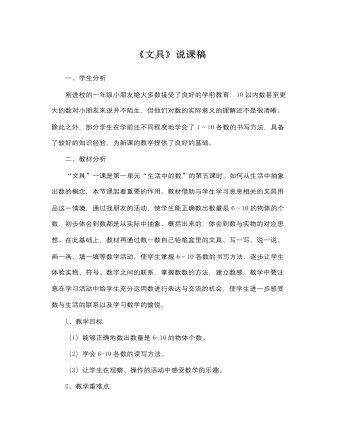
北师大版小学数学一年级上册《文具》说课稿
一、学生分析刚进校的一年级小朋友绝大多数接受了良好的学前教育,10以内数甚至更大的数对小朋友来说并不陌生,但他们对数的实际意义的理解还不是很清晰。除此之外,部分学生在学前还不同程度地学会了1~10各数的书写方法,具备了较好的知识经验,为新课的教学提供了良好的基础。二、教材分析“文具”一课是第一单元“生活中的数”的第五课时。如何从生活中抽象出数的概念,本节课起着重要的作用。教材借助与学生学习息息相关的文具用品这一情境,通过找朋友的活动,使学生能正确数出数量是6~10的物体的个数,初步体会到数都是从实际中抽象、概括出来的,体会到数与实物的对应思想。在此基础上,教材再通过数一数自己铅笔盒里的文具、写一写、说一说、画一画、填一填等数学活动,使学生掌握6~10各数的书写方法,逐步让学生体验实物、符号、数字之间的联系,掌握数数的方法,建立数感。
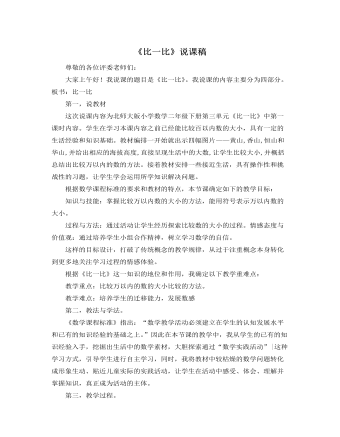
北师大版小学数学二年级下册《比一比》说课稿
解决了以上三个问题以后,我再让学生先独立将四座山的高度按照从小到大的顺序排列出来,这时,我会适当地引导学生阅读前面三个问题的解决过程,并梳理进行多位数比较的思路:先按数位比,再从高位看起。(三)分层次练习,巩固新知识在学生掌握了上述比较大数的方法以后,我将让学生运用所学的新知识,去解决”练一练”中的第1,2,5题。其中第1,2题是为了巩固“万以内的数的比较方法”,“能用符号表示万以内数的大小”这两个知识点;而第五题则是为了鼓励学生在新的情景中,进行数的大小比较。(四)课程总结这节课,同学们收获了什么?学生一定会很轻易地将上面四座山进行比较的规律说出来的。这时,我会引导学生回顾全文第四,板书设计(略)本节课,我将用最简单的文字体现重难点,便于学生理解。我的说课到此结束,谢谢大家!
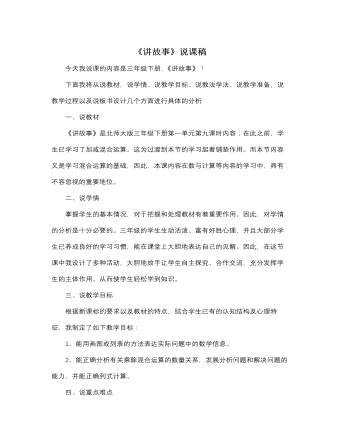
北师大版小学数学三年级下册《讲故事》说课稿
为了讲清重点、难点,使学生能达到本节设定的教学目标,我再从教法和学法上谈谈:五、说教法学法我依据“教学有法,教无定法,贵在得法”,同时为了达到既定的教学目标,突出重点,突破难点。本节课我采用的教学方法主要有创设情境法,引导启发法,同时辅以讲练结合,借助现代化的教学手段,以达到良好的教学效果。根据新课标的要求,同时又设计了与教法相适应的学法,我将“学习的主动权还给学生”,通过自主探索,合作交流等方式自主学习,真正让数学教学的课堂变成学生的课堂。六、说教学准备为了更好的达成本节课的课堂教学目标,老师学生需要做如下的教学准备:1、教具:根据教材内容自制的多媒体课件等教具。2、学具:学生以小组为单位准备表格等学具。
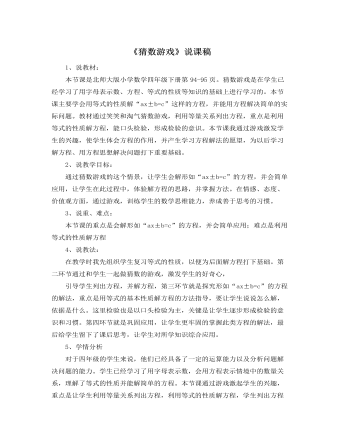
北师大版小学数学四年级下册《猜数游戏》说课稿
1、说教材:本节课是北师大版小学数学四年级下册第94-95页。猜数游戏是在学生已经学习了用字母表示数、方程、等式的性质等知识的基础上进行学习的。本节课主要学会用等式的性质解“ax±b=c”这样的方程,并能用方程解决简单的实际问题。教材通过笑笑和淘气猜数游戏,利用等量关系列出方程,重点是利用等式的性质解方程,能口头检验,形成检验的意识。本节课我通过游戏激发学生的兴趣,使学生体会方程的作用,并产生学习方程解法的愿望,为以后学习解方程、用方程思想解决问题打下重要基础。2、说教学目标:通过猜数游戏的这个情景,让学生会解形如“ax±b=c”的方程,并会简单应用,让学生在此过程中,体验解方程的思路,并掌握方法。在情感、态度、价值观方面,通过游戏,训练学生的数学思维能力,养成善于思考的习惯。3、说重、难点:本节课的重点是会解形如“ax±b=c”的方程,并会简单应用;难点是利用等式的性质解方程
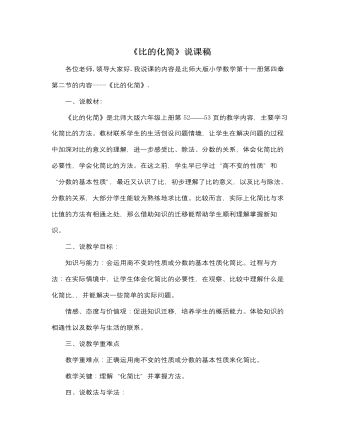
北师大版小学数学六年级上册《比的化简》说课稿
《比的化简》是北师大版六年级上册第52——53页的教学内容,主要学习化简比的方法。教材联系学生的生活创设问题情境,让学生在解决问题的过程中加深对比的意义的理解,进一步感受比、除法、分数的关系,体会化简比的必要性,学会化简比的方法。在这之前,学生早已学过“商不变的性质”和“分数的基本性质”,最近又认识了比,初步理解了比的意义,以及比与除法、分数的关系,大部分学生能较为熟练地求比值。比较而言,实际上化简比与求比值的方法有相通之处,那么借助知识的迁移能帮助学生顺利理解掌握新知识。二、说教学目标:知识与能力:会运用商不变的性质或分数的基本性质化简比。过程与方法:在实际情境中,让学生体会化简比的必要性,在观察、比较中理解什么是化简比,,并能解决一些简单的实际问题。情感、态度与价值观:促进知识迁移,培养学生的概括能力。体验知识的相通性以及数学与生活的联系。
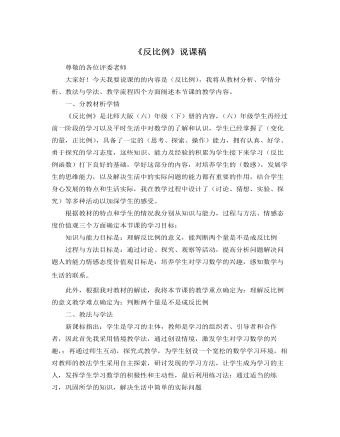
北师大版小学数学六年级下册《反比例》说课稿
知识与能力目标是:理解反比例的意义,能判断两个量是不是成反比例过程与方法目标是:通过讨论、探究、观察等活动,提高分析问题解决问题人的能力情感态度价值观目标是:培养学生对学习数学的兴趣,感知数学与生活的联系。此外,根据我对教材的解读,我将本节课的教学重点确定为:理解反比例的意义教学难点确定为:判断两个量是不是成反比例二、教法与学法新课标指出:学生是学习的主体,教师是学习的组织者、引导者和合作者,因此首先我采用情境教学法,通过创设情境,激发学生对学习数学的兴趣,;再通过师生互动,探究式教学,为学生创设一个宽松的数学学习环境,相对教师的教法学生采用自主探索,研讨发现的学习方法,让学生成为学习的主人,发挥学生学习数学的积极性和主动性,最后利用练习法:通过适当的练习,巩固所学的知识,解决生活中简单的实际问题
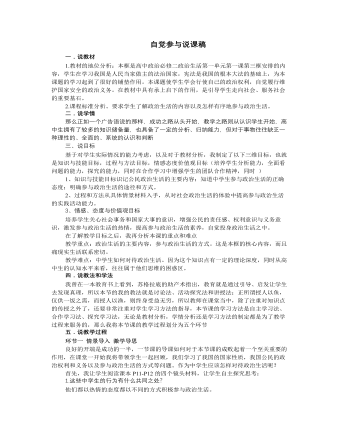
人教版高中政治必修2自觉参与说课稿
1.必须明确政治生活的作用 (政治生活与经济生活、文化生活是相辅相成的。政治生活直接影响到人民民主的实现程度,影响全体人民利益,也会影响我们的经济生活、文化生活。)2.需要学习政治知识 (5个有助于)3.需要参加政治实践活动。 (参加政治实践的途径;参加政治实践的意义)(通过情景问题,形成学生如何参与政治生活的方法;通过解决问题,培养学生解决问题的能力和发散思维的能力。)环节四 课堂小结 巩固知识本节课我采用线索性的板书,整个知识结构一目了然,为了充分发挥学生在课堂的主体地位,我将课堂小结交由学生完成,请学生根据课堂学习的内容,结合我的板书设计来进行小结,以此来帮助教师在第一时间掌握学生学习信息的反馈,同时培养学生归纳分析能力、概括能力。

人教版高中英语必修2Cultural Relics说课稿2篇
Ⅲ. Analysis of the teaching material:The topic of this unit is cultural relics. Students are quite interested in topics about different cultures around the world. This is the second period of the whole unit. As a reading class, the passage mainly talks about the history of the amber room (how it was made, sent as a gift, lost and rebuilt).According to the new national curriculum, when teaching reading, much emphasis should be put on training the students’ reading skills.Ⅳ. Teaching objectives1. Language objectives:1) Students are required to master the key words and phrases occurred in the passage (e.g. amazing, decorate, belong, in return, less than etc.)2) Students are required to learn the attributive clause and acquire the sentence pattern.2. 1) Students are required to describe a certain thing by using the new sentence patterns.2) Students are required to master two kinds of reading skills—skimming and scanning, and learn to use them in their daily reading.3. 1) Students are required to know the history of the amber room.2) Students are required to appreciate cultural relics and understand the importance of protecting them.Ⅴ. Teaching important and difficult points1) the new words, phrases, and sentence pattern in the course of reading.2) Teaching difficult point: Help the students master two kinds of reading skills—skimmingand scanning and learn to apply them in daily use.Ⅵ. Teaching methods:Task-based method & Top-down model Ⅶ. Teaching aids: PPT, pictures, blackboard Ⅷ. Teaching procedure:

人教版高中英语必修2The Olympic Games说课稿2篇
Purpose of my design:To ask the students to do these two tasks will make the Ss predict the story of this passage. As a result, it will deepen Ss’ memory of this story because they will have their own understanding of this story.Step 3. While-readingTask 1. (Individual work _____min)Skimming: ask students to skim the text and the main ideas of each paragraph in this passage. Please read it quickly and then match the sentences with the letters.Task 2. (Individual work _____min)Scanning: read the text quickly and decide the whether the following statements are true or false and give reasons.Task 3. (Pair work _____min)Listen to the tape and fill in the banks. Then read the paragraph with expression to your partner.Task4 (individual work min)Listen to the tape again and write down the main idea in one sentence.Purpose of my design: Enable students to understand the given material better by using different reading skills. And proper competition can arouse the Ss’ interest in English learning. “Task-based” teaching method is used here todevelop the Ss’ ability of communication and also their ability of co-operation will be well trainedStep 4. Post-readingTask 1. (Individual work, pair work, group work, class work; _____min)Discussion (group of 4):1. If you were Hippomenes, would you run against Atlanta?2. Do you think Hippomenes deserved to win the race? Why or why not?Step 5. HomeworkPlease read the story again carefully after class and imagine: What will happen during the race between Hippomenes and Atlanta? Who do you think will win the race? Do you think Atlanta would marry Hippomenes? Write an end for the story with thses questions.Purpose of my design: Homework is so important and necessary for to master the knowledge they learned after class. It will check whether the Ss achieve the teaching aims.Part 5 Blackboard design

人教版高中英语必修2Wildlife Protection说课稿3篇
When it comes to the students’ studying methods, I'd like to introduce my Ss first. The Ss have a good command of basic language points. They’re interested in learning English, and they take an active part in English class, so they will have fun in autonomous, cooperative and inquiry learning. I will just serve as a guide, showing them the way to explore how to make more progress in their English learning.Now it’s time for the most important stage of this lesson. My teaching procedures are arranged as follows:Step1.Leading-in (3 minute)Play a video of a wide variety of wildlife to introduce my topic. Step2. Speaking (12 minutes)We will use our textbook Page25. Let the Ss fast read the short paragraph to warm up. Ask them to talk about the report on some endangered wildlife in China with the dialogue patterns on the screen. Lastly, I will invite some groups to demonstrate their dialogues about saving wildlife in China.Step3.English play (3 minutes)Watch another video in praise of their excellent performance just now. It’s about Jack Chen’s(成龙)and Yang Ziqiong’s wildlife protection.Step4. Listening (twice 13 minutes)This time, I’ll ask the Ss to fill in the blanks of the monologue of the 2 movie stars above. Step5.Discussion (3 minutes)Which would you like to choose to wear, clothes made of cotton, artificial leather or animal skins? Why ?Step6. Summary (3 minutes)1. If there were no wildlife, there wouldn’t exist human beings. If the buying stops, the killing can, too.2. Animals are our friends. To love animals is to love ourselves. Stop hunting, killing and destroying wildlife.3. Let’s live in harmony with all the living things in the world. Step7. Music appreciation (3 minutes)Let the Ss appreciate the song Earth Song by Michael Jackson. Last but not the least, I will show you my blackboard design.

人教版高中英语必修4A taste of English Humor说课稿3篇
Then I would ask them to think of a funny English or Chinese and tell it to partners. While telling stories, they can use expressions and some acting to help make the story funny. 5 minutes would be given to do this.Those stories they told there will be the material for their writing. Soletting them tell it at first is helpful. And they can make a difference between telling a funny story and writing it down. Generally speaking, it is difficult forstudents to write well because they don’t know what to write and how to write. Asking them to tell their own stories at first can help them come up with what to write.After their telling, I would invite someone to share his/her story with all of us and I would write it down on the blackboard.This example story would be used as a sample to illustrate the format of funny story. Different from a story from teacher or textbook, a story from students can obviously become a interesting material to draw students’ attention.Then I would ask the whole class to put this story into several parts. It might be a little bit difficult for them. So I would ask them to find out whether all the sentences are necessary. After delete some sentences, there are 6 sentences left behind. Then they can easily put them into three parts. After interaction with students, I would teach them the right terms for each part and conclude the format of funny story.This step is the key and difficult point in my lesson. So I mainly usetask-based teaching method in this part and the task for students was divided into several stages. With the separated difficult level, students can find there are usually three parts in writing. They can also learn to write without the unnecessary parts in the process of analyzing. And then I wouldn’t rush to tell them the right terms to them directly. Instead, I would ask them to name them by their own. A confused mind is better for acquiring knowledge.While-writing:Then I would give students 7 minutes to write down this story, without other requirements.With all the preparations in pre-writing, students’ difficulties were cleared. So it would be much easier for them to write down the story within 7 minutes. There are no other requirements because students’ first writing is actually a drafting. It would be revise and edit several times later. Writing, as a skill

人教版高中英语必修4Women of achievement说课稿4篇
Good morning, distinguished judges:It’s my honor to talk about my teaching ideas with you. Today my topic is Women of Achievement. My presentation consists of six parts: the analysis of teaching material and student, teaching aims, key and difficult points, teaching and studying method, teaching procedures and blackboard design.First, let’s focus on the analysis of teaching material. This lesson is from New Senior English for China Student’s Book 4 Unit 1, the reading part. The main topic of the passage is the introduction of a student of Africanwildlife. After this lesson, the students will learn more information about her studying chimps in Africa, and their reading and speaking abilities can be developed as well.The next part is the analysis of students. My students are in senior high students. They have learnt English for many years, they’ve known many words and sentences, but their speaking and reading abilities are still not very good. So I will practice their speaking and reading abilities through different exercises.According to the New Standard Curriculum and the present situation, I set the teaching aims as follows: firstly, knowledge aims. Students can grasp some new words, such as worthwhile, move off. Moreover, students can understand the content of the passage and get familiar with the topic of studying chimps in wildlife. Secondly, ability aims. Students can use reading strategies such as skimming and scanning in reading process. Thirdly, emotional aims. Students can have the awareness of protecting animals and care about animals.Based on the above analysis, the key point of this lesson is to get the main idea and the detailed information from the passage; the difficult point is to talk about the wildlife protection and use reading strategies.